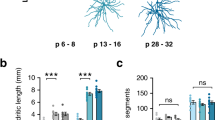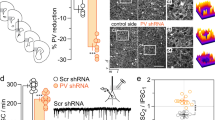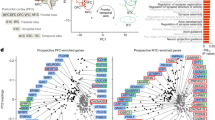Abstract
The prefrontal cortex (PFC) is a late developing region of the cortex, and its protracted maturation during adolescence may confer a period of plasticity. Closure of critical, or sensitive, periods in sensory cortices coincides with perineuronal net (PNN) expression, leading to enhanced inhibitory function and synaptic stabilization. PNN density has been found to increase across adolescence in the male rat medial PFC (mPFC). Here, we examined both male and female rats at four time points spanning adolescent development to stereologically quantify the number and intensity of PNNs in the mPFC. Additionally, because puberty coincides with broad behavioral and neuroanatomical changes, we collected tissue from age-matched pre- and post-pubertal siblings within a litter. Results indicate that both males and females show an increase in the total number and intensity of mPFC PNNs between postnatal day (P) 30 and P60. As we have previously found, white matter under the mPFC also increased at the same time. Male puberty did not affect PNNs, while female pubertal onset led to an abrupt decrease in the total number of PNNs that persisted through mid-adolescence before increasing at P60. Despite the change in PNN number, the intensity of female PNNs was not affected by puberty. Thus, though males and females show increases in mPFC PNNs during adolescence, the pubertal decrease in the number of PNNs in female rats may indicate a difference in the pattern of maximal plasticity between the sexes during adolescence.






Similar content being viewed by others

Data availability
Not applicable.
Code availability
Not applicable.
References
Akbik FV, Bhagat SM, Patel PR, Cafferty WBJ, Strittmatter SM (2013) Anatomical plasticity of adult brain is titrated by Nogo Receptor 1. Neuron 77(5):859–866. https://doi.org/10.1016/j.neuron.2012.12.027
Andersen SL (2003) Trajectories of brain development: point of vulnerability or window of opportunity? Neurosci Biobehav Rev 27(1–2):3–18. https://doi.org/10.1016/S0149-7634(03)00005-8
Anderson V, Anderson P, Northam E, Jacobs R, Catroppa C (2001) Development of executive functions through late childhood and adolescence in an Australian sample. Dev Neuropsychol 20(1):385–406. https://doi.org/10.1207/S15326942DN2001
Andrzejewski ME, Schochet TL, Feit EC, Harris R, Mckee BL, Kelley AE (2011) A comparison of adult and adolescent rat behavior in operant learning, extinction, and behavioral inhibition paradigms. Behav Neurosci 125(1):93–105. https://doi.org/10.1037/a0022038
Baarendse PJJ, Counotte DS, O’Donnell P, Vanderschuren LJMJ (2013) Early social experience is critical for the development of cognitive control and dopamine modulation of prefrontal cortex function. Neuropsychopharmacology 38(8):1485–1494. https://doi.org/10.1038/npp.2013.47
Baker KD, Gray AR, Richardson R (2017) The development of perineuronal nets around parvalbumin GABAergic neurons in the medial prefrontal cortex and basolateral amygdala of rats. Behav Neurosci 131(4):289–303. https://doi.org/10.1037/bne0000203
Balmer TS (2016) Perineuronal nets enhance the excitability of fast-spiking neurons. eneuro 3(4):1–13. https://doi.org/10.1523/ENEURO.0112-16.2016
Bhagat SM, Butler SS, Taylor JR, Mcewen BS, Strittmatter SM (2015) Erasure of fear memories is prevented by Nogo Receptor 1 in adulthood. Mol Psychiatry 21:1281–1289. https://doi.org/10.1038/mp.2015.179
Blacktop JM, Sorg BA (2019) Perineuronal nets in the lateral hypothalamus area regulate cue-induced reinstatement of cocaine-seeking behavior. Neuropsychopharmacology 44(5):850–858. https://doi.org/10.1038/s41386-018-0212-8
Blurton-Jones M, Tuszynski MH (2002) Estrogen receptor-beta colocalizes extensively with parvalbumin-labeled inhibitory neurons in the cortex, amygdala, basal forebrain, and hippocampal formation of intact and ovariectomized adult rats. J Comp Neurol 452(3):276–287. https://doi.org/10.1002/cne.10393
Brenhouse HC, Andersen SL (2011) Nonsteroidal anti-inflammatory treatment prevents delayed effects of early life stress in rats. Biol Psychiatry 70:434–440. https://doi.org/10.1016/j.biopsych.2011.05.006
Caballero A, Flores-Barrera E, Cass DK, Tseng K (2014) Differential regulation of parvalbumin and calretinin interneurons in the prefrontal cortex during adolescence. Brain Struct Funct 219:395–406. https://doi.org/10.1007/s00429-013-0508-8
Carulli D, Pizzorusso T, Kwok JCF, Putignano E, Poli A, Forostyak S, Fawcett JW (2010) Animals lacking link protein have attenuated perineuronal nets and persistent plasticity. Brain 133(8):2331–2347. https://doi.org/10.1093/brain/awq145
Casey BJ, Jones RM, Levita L, Libby V, Pattwell SS, Ruberry EJ, Somerville LH (2010) The storm and stress of adolescence: Insights from human imaging and mouse genetics. Dev Psychobiol 52(3):225–235. https://doi.org/10.1002/dev.20447
Castellano JM, Bentsen AH, Sánchez-Garrido MA, Ruiz-Pino F, Romero M, Garcia-Galiano D, Tena-Sempere M (2011) Early metabolic programming of puberty onset: Impact of changes in postnatal feeding and rearing conditions on the timing of puberty and development of the hypothalamic kisspeptin system. Endocrinology 152(9):3396–3408. https://doi.org/10.1210/en.2010-1415
Celio MR, Spreafico R, De Biasi S, Vitellaro-Zuccarello L (1998) Perineuronal nets: Past and present. Trends Neurosci 21(12):510–515. https://doi.org/10.1016/S0166-2236(98)01298-3
Chen C-Y, Storr CL, Anthony JC (2009) Early-onset drug use and risk for drug dependence problems. Addict Behav 34:319–322. https://doi.org/10.1016/j.addbeh.2008.10.021
Coleman LG, Liu W, Oguz I, Styner M, Crews FT (2014) Adolescent binge ethanol treatment alters adult brain regional volumes, cortical extracellular matrix protein and behavioral flexibility. Pharmacol Biochem Behav 116:142–151. https://doi.org/10.1038/jid.2014.371
Crone EA, Dahl RE (2012) Understanding adolescence as a period of social–affective engagement and goal flexibility. Nat Rev Neursci 13(9):636–650. https://doi.org/10.1038/nrn3313
Drzewiecki CM, Willing J, Juraska JM (2016) Synaptic number changes in the medial prefrontal cortex across adolescence in male and female rats: a role for pubertal onset. Synapse 70(9):361–368. https://doi.org/10.1002/syn.21909
Einon DF, Morgan MJ (1977) A critical period for social isolation in the rat. Dev Psychobiol 10(2):123–132. https://doi.org/10.1002/dev.420100205
Enwright JF, Sanapala S, Foglio A, Berry R, Fish KN, Lewis DA (2016) Reduced labeling of parvalbumin neurons and perineuronal nets in the dorsolateral prefrontal cortex of subjects with schizophrenia. Neuropsychopharmacology 41(9):2206–2214. https://doi.org/10.1038/npp.2016.24
Fox K (1992) A critical period for experience-dependent synaptic plasticity in rat barrel cortex. J Neurosci 12(5):1826–1838. https://doi.org/10.1523/JNEUROSCI.12-05-01826.1992
Frischknecht R, Heine M, Perrais D, Seidenbecher CI, Choquet D, Gundelfinger ED (2009) Brain extracellular matrix affects AMPA receptor lateral mobility and short-term synaptic plasticity. Nat Neurosci 12(7):897–904. https://doi.org/10.1038/nn.2338
Fuhrmann D, Knoll LJ, Blakemore SJ (2015) Adolescence as a sensitive period of brain development. Trends Cognit Sci 19(10):558–566. https://doi.org/10.1016/j.tics.2015.07.008
Giamanco KA, Morawski M, Matthews RT (2010) Perineuronal net formation and structure in aggrecan knockout mice. Neuroscience 170(4):1314–1327. https://doi.org/10.1016/j.neuroscience.2010.08.032
Gildawie KR, Honeycutt JA, Brenhouse HC (2020) Region-specific effects of maternal separation on perineuronal net and parvalbumin-expressing interneuron formation in male and female rats. Neuroscience 428:23–37. https://doi.org/10.1016/j.neuroscience.2019.12.010
Gogolla N, Caroni P, Lüthi A, Herry C (2009) Perineuronal nets protect fear memories from erasure. Science 325(5945):1258–1261. https://doi.org/10.1126/science.1174146
Gogtay N, Giedd JN, Lusk L, Hayashi KM, Greenstein D, Vaituzis AC, Nugent III TF, Herman DH, Clasen LS, Toga AW, Rapoport JL, Thompson PM (2004) Dynamic mapping of human cortical development during childhood through early adulthood. Proc Nat Acad Sci 101(21):8174–8179. https://doi.org/10.1073/pnas.0402680101
Happel MFK, Niekisch H, Castiblanco Rivera LL, Ohl FW, Deliano M, Frischknecht R (2014) Enhanced cognitive flexibility in reversal learning induced by removal of the extracellular matrix in auditory cortex. Proc Natl Acad Sci USA 111(7):2800–2805. https://doi.org/10.1073/pnas.1310272111
Härtig W, Brauer K, Bruckner G (1992) Wisteria floribunda agglutinin-labelled nets surround parvalbumin-containing neurons. Mol Neurosci 3(10):869–872. https://doi.org/10.1097/00001756-199210000-00012
Härtig W, Brauer K, Bigl V, Briickner G (1994) Chondroitin sulfate proteoglycan-immunoreactivity of lectin-labeled perineuronal nets around parvalbumin-containing neurons. Brain Res 635:307–311. https://doi.org/10.1016/0006-8993(94)91452-4
Härtig W, Derouiche A, Welt K, Brauer K, Grosche J, Mäder M, Brückner G (1999) Cortical neurons immunoreactive for the potassium channel Kv31.b subunit are predominantly surrounded by perineuronal nets presumed as a buffering system for cations. Brain Res. https://doi.org/10.1016/S0006-8993(99)01784-9
Herting MM, Gautam P, Spielberg JM, Dahl RE, Sowell ER (2015) A longitudinal study: changes in cortical thickness and surface area during pubertal maturation. PLoS ONE 10(3):e0119774. https://doi.org/10.1371/journal.pone.0119774
Hensch TK (2004) Critical period regulation. Annu Rev Neurosci 27(1):549–579. https://doi.org/10.1146/annurev.neuro.27.070203.144327
Hensch TK (2005) Critical period plasticity in local cortical circuits. Nat Rev Neurosci 6(11):877–888. https://doi.org/10.1038/nrn1787
Hidalgo-Lopez E, Pletzer B (2017) Interactive effects of dopamine baseline levels and cycle phase on executive functions: the role of progesterone. Front Neurosci 11(JUL):1–14. https://doi.org/10.3389/fnins.2017.00403
Hylin MJ, Orsi SA, Moore AN, Dash PK (2013) Disruption of the perineuronal net in the hippocampus or medial prefrontal cortex impairs fear conditioning. Learn Mem 20(5):267–273. https://doi.org/10.1101/lm.030197.112
Jitsuki S, Nakajima W, Takemoto K, Sano A, Tada H, Takahashi-Jitsuki A, Takahashi T (2016) Nogo receptor signaling restricts adult neural plasticity by limiting synaptic AMPA receptor delivery. Cereb Cortex 26:427–439. https://doi.org/10.1093/cercor/bhv232
Kawata M (1995) Roles of steroid hormones and their receptors in organization in the nervous system structural. Neurosci Res 24:1–46. https://doi.org/10.1016/0168-0102(96)81278-8
Kessler RC, Berglund P, Demler O, Jin R, Merikangas KR, Walters EE (2005) Lifetime prevalence and age-of-onset distributions of DSM-IV disorders in the national comorbidity survey replication. Arch Gen Psychiatry 62(6):593–602. https://doi.org/10.1001/archpsyc.62.6.593
Kim JH, Li S, Richardson R (2011) Immunohistochemical analyses of long-term extinction of conditioned fear in adolescent rats. Cereb Cortex 21(3):530–538. https://doi.org/10.1093/cercor/bhq116
Korenbrot CC, Huhtaniemi IT, Weiner RI (1977) Preputial separation as an external sign of pubertal development in the male rat. Biol Reprod 17(2):298–303. https://doi.org/10.1095/biolreprod17.2.298
Koss WA, Franklin AD, Juraska JM (2011) Delayed alternation in adolescent and adult male and female rats. Dev Psychobiol 53(7):724–731. https://doi.org/10.1002/dev.20543
Koss WA, Lloyd MM, Sadowski RN, Wise LM, Juraska JM (2015) Gonadectomy before puberty increases the number of neurons and glia in the medial prefrontal cortex of female, but not male, rats. Dev Psychobiol 57(3):305–312. https://doi.org/10.1002/dev.21290
Kougias DG, Cortes LR, Moody L, Rhoads S, Pan Y, Juraska JM (2018) Effects of perinatal exposure to phthalates and a high-fat diet on maternal behavior and pup development and social play. Endocrinology 159(2):1088–1105. https://doi.org/10.1210/en.2017-03047
Larsen B, Luna B (2018) Adolescence as a neurobiological critical period for the development of higher-order cognition. Neurosci Biobehav Rev 94:179–195. https://doi.org/10.1016/j.neubiorev.2018.09.005
Lenroot RK, Giedd JN (2006) Brain development in children and adolescents: insights from anatomical magnetic resonance imaging. Neurosci Biobehav Rev 30(6):718–729. https://doi.org/10.1016/j.neubiorev.2006.06.001
Markham JA, Morris JR, Juraska JM (2007) Neuron number decreases in the rat ventral, but not dorsal, medial prefrontal cortex between adolescence and adulthood. Neuroscience 144:961–968. https://doi.org/10.1016/j.neuroscience.2006.10.015
Matsumoto YK, Kasai M, Tomihara K (2018) The enhancement effect of estradiol on contextual fear conditioning in female mice. PLoS ONE 13(5):1–14. https://doi.org/10.1371/journal.pone.0197441
Mauney SA, Athanas KM, Pantazopoulos H, Shaskan N, Passeri E, Berretta S, Woo TUW (2013) Developmental pattern of perineuronal nets in the human prefrontal cortex and their deficit in schizophrenia. Biol Psychiatry 74(6):427–435. https://doi.org/10.1016/j.biopsych.2013.05.007
McCallum J, Kim JH, Richardson R (2010) Impaired extinction retention in adolescent rats: effects of d-cycloserine. Neuropsychopharmacology 35(10):2134–2142. https://doi.org/10.1038/npp.2010.92
McGee AW, Strittmatter SM (2003) The Nogo-66 receptor: focusing myelin inhibition of axon regeneration. Trends Neurosci 26(4):193–198. https://doi.org/10.1016/S0166-2236(03)00062-6
McGee AW, Yang Y, Fischer QS, Daw NW, Strittmatter SM (2005) Experience-driven plasticity of visual cortex limited by myelin and Nogo receptor. Science 309(5744):2222–2226. https://doi.org/10.1038/jid.2014.371
Milad MR, Igoe SA, Lebron-Milad K, Novales JE (2009) Estrous cycle phase and gonadal hormones influence conditioned fear extinction. Neuroscience 164:887–895. https://doi.org/10.1016/j.neuroscience.2009.09.011
Mix A, Hoppenrath K, Funke K (2015) Reduction in cortical parvalbumin expression due to intermittent theta-burst stimulation correlates with maturation of the perineuronal nets in young rats. Dev Neurobiol 75(1):1–11. https://doi.org/10.1002/dneu.22205
Morellini F, Sivukhina E, Stoenica L, Oulianova E, Bukalo O, Jakovcevski I, Schachner M (2010) Improved reversal learning and working memory and enhanced reactivity to novelty in mice with enhanced GABAergic innervation in the dentate gyrus. Cereb Cortex 20:2712–2727. https://doi.org/10.1093/cercor/bhq017
Nemati F, Kolb B (2012) Recovery from medial prefrontal cortex injury during adolescence: implications for age-dependent plasticity. Behav Brain Res 229(1):168–175. https://doi.org/10.1016/j.bbr.2012.01.002
Newman L, Mcgaughy J (2011) Adolescent rats show cognitive rigidity in a test of attentional set shifting. Dev Psychobiol 53(4):391–401. https://doi.org/10.1002/dev.20537
Nguyen T-V, Mccracken J, Ducharme S, Botteron KN, Mahabir M, Johnson W, Israel M, Evans AC, Karama S, Brain Development Cooperative Group (2012) Testosterone-related cortical maturation across childhood and adolescence. Cerebral Cortex 23(6):1424–1432. https://doi.org/10.1093/cercor/bhs125
Pattwell SS, Duhoux S, Hartley CA, Johnson DC, Jing D, Elliott MD, Lee FS (2012) Altered fear learning across development in both mouse and human. Proc Natl Acad Sci USA 109(40):16318–16323. https://doi.org/10.1073/pnas.1206834109
Perry CJ, Ganella DE, Nguyen LD, Du X, Drummond KD, Whittle S, Kim JH (2020) Assessment of conditioned fear extinction in male and female adolescent rats. Psychoneuroendocrinology 116:104670. https://doi.org/10.1016/j.psyneuen.2020.104670
Piekarski DJ, Boivin JR, Wilbrecht L (2017) Ovarian hormones organize the maturation of inhibitory neurotransmission in the frontal cortex at puberty onset in female mice. Curr Biol 27(12):1735–1745. https://doi.org/10.1016/j.cub.2017.05.027
Peper JS, Brouwer RM, Schnack HG, van Baal GC, van Leeuwen M, van den Berg SM, Delemarre-Van de Waal HA, Boomsma DI, Kahn RS, Hulshoff Pol HE (2009) Sex steroids and brain structure in pubertal boys and girls. Psychoneuroendocrinology 34:332–342. https://doi.org/10.1016/j.psyneuen.2008.09.012
Perrin JS, Leonard G, Perron M, Pike GB, Pitiot A, Richer L, Veillette S, Pausova Z, Paus T (2009) Sex differences in the growth of white matter during adolescence. NeuroImage 45:1055–1066. https://doi.org/10.1016/j.neuroimage.2009.01.023
Pizzorusso T, Medini P, Berardi N, Chierzi S, Fawcett JW, Maffei L (2002) Reactivation of ocular dominance plasticity in the adult visual cortex. Science 298(5596):1248–1251. https://doi.org/10.1126/science.1072699
Romberg C, Yang S, Melani R, Andrews MR, Horner AE, Spillantini MG, Saksida LM (2013) Depletion of perineuronal nets enhances recognition memory and long-term depression in the perirhinal cortex. J Neurosci 33(16):7057–7065. https://doi.org/10.1523/JNEUROSCI.6267-11.2013
Sale A, Maya Vetencourt JF, Medini P, Cenni MC, Baroncelli L, De Pasquale R, Maffei L (2007) Environmental enrichment in adulthood promotes amblyopia recovery through a reduction of intracortical inhibition. Nat Neurosci 10(6):679–681. https://doi.org/10.1038/nn1899
Santini E, Quirk GJ, Porter JT (2008) Fear conditioning and extinction differentially modify the intrinsic excitability of infralimbic neurons. J Neurosci 28(15):4028–4036. https://doi.org/10.1523/JNEUROSCI.2623-07.2008
Seeger G, Brauer K, Härtig W, Brückner G (1994) Mapping of perineuronal nets in the rat brain stained by colloidal iron hydroxide histochemistry and lectin cytochemistry. Neuroscience 58(2):371–388. https://doi.org/10.1016/0306-4522(94)90044-2
Selemon LD (2013) A role for synaptic plasticity in the adolescent development of executive function. Transl Psychiatry 3(3):e238. https://doi.org/10.1038/tp.2013.7
Sellinger EP, Kougias DG, Drzewiecki CM, Juraska JM (2020) Behavioral effects in adult rats exposed to low doses of a phthalate mixture during the perinatal or adolescent period. Neurotoxicol Teratol 79(March):106886. https://doi.org/10.1016/j.ntt.2020.106886
Shughrue PJ, Stumpf WE, Maclusky NJ, Zielinski JE, Hochberg RB (1990) Developmental changes in estrogen receptors in mouse cerebral cortex between birth and postweaning: Studied by autoradiography with 11 beta-methoxy-16 alpha-[125I]iodoestradiol. Endocrinology 126(2):1112–1124. https://doi.org/10.1210/endo-126-2-1112
Sierra-Mercado D, Padilla-Coreano N, Quirk GJ (2011) Dissociable roles of prelimbic and infralimbic cortices, ventral hippocampus, and basolateral amygdala in the expression and extinction of conditioned fear. Neuropsychopharmacology 36(2):529–538. https://doi.org/10.1038/npp.2010.184
Slaker M, Churchill L, Todd RP, Blacktop JM, Zuloaga DG, Raber J, Sorg BA (2015) Removal of perineuronal nets in the medial prefrontal cortex impairs the acquisition and reconsolidation of a cocaine-induced conditioned place preference memory. J Neurosci 35(10):4190–4202. https://doi.org/10.1523/JNEUROSCI.3592-14.2015
Slaker ML, Harkness JH, Sorg BA (2016) A standardized and automated method of perineuronal net analysis using Wisteria floribunda agglutinin staining intensity. IBRO Rep 1:54–60. https://doi.org/10.1016/j.ibror.2016.10.001
Snyder KP, Barry M, Valentino RJ (2015) Cognitive impact of social stress and coping strategy throughout development. Psychopharmacology 232(1):185–195. https://doi.org/10.1007/s00213-014-3654-7
Sorg BA, Berretta S, Blacktop JM, Fawcett JW, Kitagawa H, Kwok JCF, Miquel M (2016) Casting a wide net: role of perineuronal nets in neural plasticity. J Neurosci 36(45):11459–11468. https://doi.org/10.1523/JNEUROSCI.2351-16.2016
Sowell ER, Thompson PM, Colin J, Jernigan TL, Toga AW (1999) In vivo evidence for maturation in frontal and striatal regions. Nature Neurosci 2(10):859–861. https://doi.org/10.1038/13154
Spear LP (2000) The adolescent brain and age-related behavioral manifestations. Neurosci Biobehav Rev 24(4):417–463. https://doi.org/10.1016/s0149-7634(00)00014-2
Stoica T, Kathleen L, Farah K, Melina N, Brendan R, Depue E (2019) Cortical morphometry and structural connectivity relate to executive function and estradiol level in healthy adolescents. Brain Behav. https://doi.org/10.1002/brb3.1413
Taylor SJ, Barker LA, Heavey L, McHale S (2013) The typical developmental trajectory of social and executive functions in late adolescence and early adulthood. Dev Psychol 49(7):1253–1265. https://doi.org/10.1037/a0029871
Trask S, Reis DS, Ferrara NC, Helmstetter FJ (2020) Decreased cued fear discrimination learning in female rats as a function of estrous phase. Learn Mem 27(6):254–257. https://doi.org/10.1101/lm.051185.119
Ueno H, Suemitsu S, Okamoto M, Matsumoto Y, Ishihara T (2017) Parvalbumin neurons and perineuronal nets in the mouse prefrontal cortex. Neuroscience 343:115–127. https://doi.org/10.1016/j.neuroscience.2016.11.035
Urban KR, Geng E, Bhatnagar S, Valentino RJ (2019) Age- and sex-dependent impact of repeated social stress on morphology of rat prefrontal cortex pyramidal neurons. Neurobiol Stress 10(April):100165. https://doi.org/10.1016/j.ynstr.2019.100165
Wiesel TN, Hubel D (1970) The period of susceptibility to the physiological effects of unilateral eye closure in kittens. J Physiol 206(2):419–436. https://doi.org/10.1113/jphysiol.1970.sp009022
Willing J, Juraska JM (2015) The timing of neuronal loss across adolescence in the medial prefrontal cortex of male and female rats. Neuroscience 301:268–275. https://doi.org/10.1016/j.neuroscience.2015.05.073
Willing J, Drzewiecki CM, Cuenod BA, Cortes LR, Juraska JM (2016) A role for puberty in water maze performance in male and female rats. Behav Neurosci 130(4):422–427. https://doi.org/10.1037/bne0000145
Yamaguchi Y (2000) Lecticans: organizers of the brain extracellular matrix. Cell Mol Life Sci 57(2):276–289. https://doi.org/10.1007/PL00000690
Yang EJ, Lin EW, Hensch TK (2012) Critical period for acoustic preference in mice. Proc Natl Acad Scie USA 109(SUPPL2):17213–17220. https://doi.org/10.1073/pnas.1200705109
Yates MA, Juraska JM (2008) Pubertal ovarian hormone exposure reduces the number of myelinated axons in the splenium of the rat corpus callosum. Exp Neurol 209(1):284–287. https://doi.org/10.1016/j.expneurol.2007.09.013
Zeidan MA, Igoe SA, Linnman C, Vitalo A, Levine JB, Klibanski A, Milad MR (2011) Estradiol modulates medial prefrontal cortex and amygdala activity during fear extinction in women and female rats. Biol Psychiatry 70(10):920–927. https://doi.org/10.1016/j.biopsych.2011.05.016
Acknowledgements
We thank the core facilities at the Carl R. Woese Institute for Genomic Biology for use of the NanoZoomer Slide Scanner and Katherine Janssen for her guidance. We also thank Beckman Institute Imaging Technology Group for use of the stereology microscopy suite.
Funding
This work was supported by National Institute of Environmental Health Sciences P01 ES002848-Project 3, United States Environmental Protections Agency 83543401 Project 3, and National Institute of Environmental Health Sciences R21 ES026896.
Author information
Authors and Affiliations
Contributions
All authors contributed to the conceptualization of this study. Study design, data collection, and all statistical analyses were performed by CMD. JW contributed to the methodology. The first draft of the manuscript was written by CMD and all authors commented on the manuscript. JMJ supervised all work and was responsible for funding.
Corresponding author
Ethics declarations
Conflict of interest
The authors declare that they have no conflict of interest.
Additional information
Publisher's Note
Springer Nature remains neutral with regard to jurisdictional claims in published maps and institutional affiliations.
Rights and permissions
About this article
Cite this article
Drzewiecki, C.M., Willing, J. & Juraska, J.M. Influences of age and pubertal status on number and intensity of perineuronal nets in the rat medial prefrontal cortex. Brain Struct Funct 225, 2495–2507 (2020). https://doi.org/10.1007/s00429-020-02137-z
Received:
Accepted:
Published:
Issue Date:
DOI: https://doi.org/10.1007/s00429-020-02137-z



